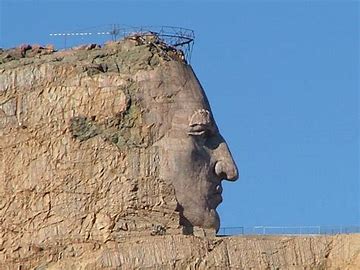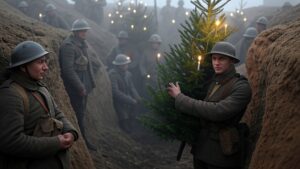HE’S EVERYWHERE: GEORGE ARMSTRONG CUSTER
“Now ordinary people are born forwards in Time, if you understand what I mean, and nearly everything in the world goes forward too. This makes it quite easy for the ordinary people to live, just as it would be easy to join those five dots into a W if you were allowed to look at them forwards, instead of backwards and inside out. But I unfortunately was born at the wrong end of time, and I have to live backwards from in front, while surrounded by a lot of people living forwards from behind. Some people call it having a second sight.”
Merlyn
The Sword in the Stone
“Custer was a figure larger than life, unbelievable in so many ways, and he attracted myths. In a sense, Custer was part of the Mike Fink-Paul Bunyan tall-tale tradition of America. More nonsense has been said, written and believed about him than any other Army officer.”
Stephen E. Ambrose[1]
One of my favorite pieces of personal artwork is a picture of Merlyn—dressed in a sorcerer’s gown of purple with white stars—holding a Chinese child and feeding him with chopsticks out of a porcelain bowl decorated with an intricate Chinese dragon design. I titled the picture “Merlyn Feeds Mao.” The artwork now resides—as so many of my other pieces do—in a tub buried deep in a storage unit located outside of Winchester, Virginia.
Whether it be art, religion, movies, particle physics or literature, I love themes which play with the notion of the arrow of Time. That’s why I love the works of T. H. White[2] so much, particularly his accounts of King Arthur, Wart, and Merlyn—the latter being a character who moves backward in time. In chapter 20, of The Once and Future King, for example, “Merlyn looked younger every year—which was only natural, because he was.”[3] All of which prompted King Arthur to ask (in chapter four of The Queen of Air and Darkness), “I wish [Merlyn] had been born forwards like other people.”[4]
So, you may ask, what does all this have to do with George Armstrong Custer and our recently concluded grand tour of the West and Midwest U.S.A.? I hope my logic is not a stretch too far for some of you. At several places during our trek, we encountered and crisscrossed locations identified with the historical General Custer—interestingly enough, in reverse order, as though we were tracking a Merlyn-type character—beginning with the last and most controversial event first (the Battle of Little Big Horn) and working backward in his flamboyant and controversial career.
For some reason, I thought it may make an interesting missive.
Our first encounter, in many ways, was the most memorable. After spending several days with our friends Gary and Madeline Gibson in Pocatello, Idaho—punctuated by a trip to Las Vegas and my whirlwind trip to Texas with the Westwin Elements team—Ima and I drove north to Montana, skirting the western edge of Yellowstone National Park and passing through Big Sky skiing territory. I convinced Ima that we needed to visit the site of Custer’s “last stand,” which I had been to a couple years earlier with my sister during a hurried visit.
We arrived at the battlefield site on a hot, sweltering day.
The kind of day it was on June 25, 1876.
Custer’s last day.
A place where his wife Libbie and journalists subsequently created the myth of a gallant “last stand.”
Actually, it was a massacre.
A rout.
Probably over in less than a half hour in the late afternoon.
Custer and his men of the Seventh Calvary Regiment were overwhelmed by a combined force of over 1,500-2,500 mounted Lakota Sioux, Northern Cheyenne, and Arapaho warriors.
We call it the Battle of the Little Bighorn—named after the river meandering below the fatal bluff and through the tribal Crow reservation lands—and it was the most significant confrontation of the Great Sioux War.
The Lakota call it the Battle of the Greasy Grass.
Today, you can drive along the bluff and listen to a recorded message retracing the various phases of the battle and observe the gravestones on “Custer Hill,” including one black marker, designating the spot where Custer was cut down.
Custer’s final fight and battle movements are a matter of conjecture and controversy. There were no human survivors among Custer’s battalion (roughly 210 men in five companies under his immediate command, including two of Custer’s brothers, a nephew, and a brother-in-law). Eyewitness accounts provided by Indians after the battle were often conflicting or unclear.
As I stood for my second time at the battle site, I tried to envision the sights, sounds and smells of Custer’s final agonizing moments with his men and horses—reportedly exhausted from long, forced rides—desperately struggling to reach the crest of the bluff. At what point did Custer realize that he had grossly underestimated the size and fighting resolve of the Indian force—led by, among others an Oglala Lakota warrior named Crazy Horse? I tried to imagine the blood-curdling screams, war cries and thundering hooves of a thousand tribal horsemen breaking like waves over Custer and his men. I tried to visualize the fear in their eyes, the pain of arrows and bullets. I tried to force my nose to detect the smells of rifle smoke and human and horse blood on the bluff (Custer and his men used the horses shot out from under them as an equine breastworks of sorts).
By the time General Terry’s force reached the battlefield site two days later, they found Custer’s body with gunshot wounds to the chest and head (subsequent speculation is that he was shot in the head after he was already dead.) When they arrived, they found that the Lakota and Cheyenne had already removed their dead from the field. Most of Custer’s dead men had been stripped of their clothing, ritually mutilated, and in a state of decomposition, making identification of many impossible.[5] Following the battle, tribal women may have used stone “mallets” with rawhide handles to finish off the wounded.[6]
Custer’s remains are separated from the bluff where he met his fate. Instead, he is buried beneath a large monument on the grounds of West Point Military Academy—where despite hundreds of demerits, he graduated last in his class in late June 1861 (apparently to a raucous round of cheers from his classmates).[7] Buried at his side, next to her beloved “Autie”—lies Libbie Bacon Custer. Her loyalty to her husband never flagged. Through fifty-seven years of widowhood, she defended her husband’s reputation and, largely as a result of her dogged efforts created a popularly accepted version of Custer’s gallant last stand. She also put the blame for the disaster squarely on the shoulders of Major Reno and Captain Benteen who had betrayed Custer by not following orders.[8]
Ima and I left the battle site and drove through the Black Hills toward Lead, South Dakota. The Black Hills—a small mountain range rising from the Great Plains to western South Dakota into Wyoming (the tallest peak is over 7,000 feet high)—is called by the Lakota tribe Paha Sapa, meaning “the heart of everything that is.” For local tribes, the hills are considered a holy site. The first white trappers and hunters called them the black hills because of their dark hue from a distance, where the slopes were covered in evergreen trees.[9]
From Lead, it was a short drive to the impressive Crazy Horse Monument, commemorating the most erstwhile adversary of Custer. The site was Ima’s favorite stop on our entire trip. One’s first impression of the monument is its scale; it is said that the all the presidential heads of Mount Rushmore could fit under Crazy Horse’s still unfinished arm. The memorial granite carving began in 1948, after it was commissioned by Henry Standing Bear (a Lakota elder), to be sculpted by Korczak Ziolkowski. The monument is being carved out of Thunderhead Mountain, a place considered sacred by some Oglala Lakota, and is located roughly 17 miles from Mount Rushmore. Today, there is no final timetable for the project’s completion; by 2037, the team of artists and explosive experts anticipate that the hand, arm, shoulder, hairline, and top of the horse’s head will be finished. The original idea was a giant carving of Crazy Horse riding his horse and pointing toward tribal lands. The face, completed in 1998, by itself stands 87 feet and six inches high, the outstretched arm will be 263 feet long, and the finger 29 feet and six inches long. By any measure, it is a breathtaking sight and we feel blessed we were able to see it.
Ima liked it because no state or federal money is involved in the project—Ziolkowski was reportedly offered $10 million for the project when it first started but turned the offer down. The project is currently funded by visitor entry fees and private donations. The monument is operated by a nonprofit organization, the Crazy Horse Memorial Foundation, and today the site includes a Native American school, a cultural museum and cultural center
Crazy Horse (1840-1877)—in the Lakota tongue Thasunke Witko (literally “His-Horse-Is-Crazy”)—was an Oglala tribe warrior leader. The Oglala tribe, in turn, was one of the seven subtribes of the Lakota people.[10] Crazy Horse was a great hunter and tribal braves willingly followed Crazy Horse into battle because they thought his “medicine” was most powerful. According to Ambrose’s account, in the early 1860’s Crazy Horse was given a medicine man’s special charm to ward off danger—a little white stone with a hole through it—that the warrior wore slung over his shoulder and under his left arm. It worked! Although Crazy Horse had eight horses killed under him, he was never wounded by an enemy of the Oglalas. Another reason braves so willingly followed him was his reputation for never leaving a brave on the field of battle, whether it be the numerous intertribal skirmishes they fought or against the white invaders.[11]
Interestingly enough, Crazy Horse was not an Oglala Lakota chief but rather a “shirt wearer” or war leader (Ogle Tanka Un), an honorific title—perhaps derived from the term for “decider”—bestowed on a small, select group of warriors in recognition of great battlefield accomplishments and good deeds for the tribe. Crazy Horse was one of four “shirt wearers” who acted as counselors to higher-ranking tribal members—the “Fat Bellies”—of the tribal council on matters of hunting grounds, campsites and war.[12] They wore shirts decorated with patterned bands of quillwork and beadwork reflecting their accomplishments, with hair lock fringes on the sleeves.
In comparison to the flamboyant, attention-seeking Custer, Crazy Horse was quiet, shunned having his photograph taken and was buried in an unknown location. Never beaten in battle, he surrendered to U.S. military authorities to save his tribe and was fatally bayoneted by a soldier while incarcerated at Fort Robinson (in the present-day state of Nebraska) on September 5, 1877.
Upon leaving the Crazy Horse Monument and heading back to our hotel in Lead, we passed the road leading to Custer, South Dakota. Nuggets of gold were first found in the Blacks Hills near the town of Custer. That discovery would change American history. Sioux Indian tribes in the Black Hills area knew gold drove the white man crazy. Ambrose recounts a story from the early 1840’s, after local Indians found some gold, when a large gathering of Indian warriors met, including Worm, Crazy Horse’s father. The council agreed that any Indian who revealed the presence of gold in the Black Hills to a white man, or any white man who discovered it, was to be slain.[13]
So, how was gold discovered in the Black Hills? Again, it was the colorful and controversial George Armstrong Custer—a bit less than two years before the Battle of Little Bighorn—who played the pivotal role. In early July 1874, during the presidential administration of fellow Union wartime leader Ulysses S. Grant, Custer volunteered to head one of the most famous military expeditions in American history, perhaps second only to the Lewis and Clark Expedition. Custer gathered an expeditionary force of over one thousand men and two thousand horses and mules—including ten companies of the 7th Cavalry, two infantry companies, Gatling guns, over 100 Indian scouts, two miners to look for gold, a geologist, a photographer and four journalists—requiring a train of over 100 wagons. On July 2, 1874, the column pulled out of Fort Abraham Lincoln (just south of Bismarck, North Dakota) with Custer riding his favorite horse “Dandy” at its head with a band playing “Garry Owen” as they left.[14]
What a spectacle it must have been!
The problem: the Black Hills had been promised to the Sioux tribes forever in the treaty of 1868. As Grant’s political opponents pointed out back East, the expedition was blatantly illegal and an effort to divert the nation from its problems. But more than politics was involved. The Panic of 1873 resulted in a nationwide (then 37 states) depression and the need to find and mint more gold. Moreover, there was a growing sense of manifest destiny with open spaces to conquer and last, but not least, plans for a Northern Pacific Railroad through the area.
Custer pushed the column hard despite the blazing sun and a mostly treeless prairie terrain. He had the men up by 3 a.m., on the march by 4 a.m., and often not in bed until after midnight. By July 22, he approached the Black Hills and almost all of his Indian scouts left him (fearing Sioux retaliation and the logistical problem of such a large wagon train in the Hills). But Custer pressed on. On July 27th, near present-day Custer S.D., miners with the expedition found what they were looking for. They panned several gold particles from French Creek. Custer sent one of his best remaining scouts to Fort Laramie with the news: by the end of August 1874, the New York Tribune and other newspapers were carrying the story of gold discovered in the Black Hills.[15]
Custer’s expeditionary force returned to Fort Abraham Lincoln on August 10. The expedition had covered 1,205 miles in sixty days—a remarkable feat in those days. There was very little Indian resistance on the trip, prompting Custer to snort famously: “I could whip all the Indians in the northwest with the Seventh Cavalry.” As we have seen, the saying—and the arrogance behind it—would come back to haunt him.[16]
The Indians were right: the discovery of gold drove the white man crazy. By March 1876 (following a horrific winter on the Plains in 1875) there were no less than 11,000 white men in the frontier town of Custer alone, more than 15,000 altogether in the Black Hills—outnumbering the native Oglalas on the Sioux agencies—and thousands more were coming.[17]
The next day, from our mountain-top hotel in Lead, Ima and I visited the nearby remarkable frontier gold-mining town of Deadwood, South Dakota where we witnessed firsthand the historical effects of the gold frenzy. There is no evidence (at least that I have found) that Custer ever visited Deadwood. As I related in a previous missive,[18] this was the town where “Wild Bill” Hickok was famously shot in the back at Nuttal & Mann’s Saloon–the No. 10 Saloon—holding his now famous “dead man’s hand.”
But Hickok knew “the boy general” Custer—and his beautiful young wife Libbie—very well. In September 1866, after Hickok returned from an expedition to Santa Fe, he spent time at Fort Riley (Kansas) where the Seventh Cavalry Regiment was being organized, under its new commander Lieutenant Colonel Custer. Both Custer and his wife were quite taken by Hickok, to the point that Libbie spent her latter years in life fighting off rumors of an affair with “Wild Bill.”[19] By the late summer of 1867,[20] Custer was serving under Major General Winfield Scott Hancock—famous for repulsing Pickett’s charge at Gettysburg—and engaged in one of several Army military campaigns against the Indians. At the time, “Wild Bill” was one of Hancock’s best scouts and among the West’s foremost authorities on Indian customs and tactics. Custer, a good learner, soaked in as much as he could.
Back to the gold frenzy: narrow Deadwood Gulch once hosted a population of over 10,000 gold-thirsty prospectors and frontiersmen during the heyday of the “Black Hills Gold Rush” in 1876.
A gold rush made possible by Custer’s expedition.
As we left behind Little Big Horn, the Crazy Horse Monument and Deadwood in our rear-view mirror we encountered several more historical markers tracing the route of Custer and his grand expedition to the Blacks Hills. So, as we drove further eastward across South Dakota and southward to Missouri, we eventually crossed the Mississippi River. In a few days, we would pick up Custer’s trail again—backward in time—to his experience as a Union officer in the Civil War.
But that is another missive.
[1] Stephen E. Ambrose, Crazy Horse and Custer: The Parallel Lives of Two American Warriors, (Anchor Books: New York), 1996, pp. 234-235. I picked up this book at the museum at the Battle of Little Big Horn during our drive through Montana. The myth Ambrose was referring to was Custer’s relationship, some rumored a child, with a Cheyenne squaw named Mo-nah-se-tah, who was captured at the battle of Washita.
[2] Terrence Hanbury “Tim” White (1906-1964), was an English writer best known for his Arthurian novels (gathered together as The Once and Futuree King in 1958). The book is one of my personal favorites and over the years I have read passages from it to my girls and grandchildren. See, “T. H. White Dead; Novelist was 57,” The New York Times, Jan 18, 1964.
[3] T. H. White, The Once and Future King (Collins, 1958).
[4] T. H. White, The Queen of Air and Darkness (original title The Witch in the Wood), (G. P. Putnam’s Sons, 1939).
[5] E. A. Brininstool, A Trooper With Custer, 1925, pp. 60-62.
[6] Douglas D. Scott, et.al., They Died With Custer: Soldiers’ Bones From the Battle of Little Bighorn, 1998.
[7] Ambrose, Crazy Horse and Custer, pp. 115-116.
[8] Ibid., pp. 477-478.
[9] “Black Hills National Forest—Frequently Asked Questions,” Unites States Forest Service; see also, a good treatment of the subject in the Wikipedia article.
[10] Today, the Oglala’s live on the Pine Ridge Indian Reservation in South Dakota, and with almost 47,000 registered tribal members, constitute the eighth largest Naftive American reservation in the U.S. See, “Oglala Sioux Tribe: A Profile”; and, Barry M. Pritzker, “A Native American Encyclopedia: History, Culture, and Peoples. (Oxford Univ. Press, 2000).
[11] Ambrose, Crazy Horse and Custer, pp. 130-133.
[12] In the process of researching this missive, I have become fascinated with the topic of Indian “shirt wearers.” A good treatment of the topic and the Ogala Lakota initiation ceremony can be found in Ambrose, Crazy Horse and Custer, pp. 135-137. See also, “Treasures of the IACB: Oglala Lakota Leader Shirt,” U.S. Department of the Interior (Indian Arts and Crafts Board), Nov. 26, 2019.
[13] Ambrose, Crazy Horse and Custer, p. 374, citing Edgar I. Stewart, Custer’s Luck (1955), p. 61.1w
[14] Ambrose, Crazy Horse and Custer, pp. 375-377; Max E. Gerber, “The Black Hills Expedition of 1874: A New Look,” South Dakota History, June-July 1970, p. 8.
[15] Ibid., p. 379.
[16] Reiger, ed., The Passing of the Great West, p. 106; Ambrose, Crazy Horse and Custer, p. 380.
[17] Ambrose, Crazy Horse and Custer, p. 395, citing Robinson, A History of the Dakota, p. 421.
[18] Akers, “From ‘Wild Bill’ Hickok’ And Kamran Khozan To Neutrinos,” Sep 2022.
[19] Tom Clavin, Wild Bill: The True Story of the American Frontier’s First Gunfighter,” (St. Martin’s Griffin: NY), 2019, pp. 78-79. I bought this book at the famous Wall Drug Store in Wall, S.D. The book has a much different narrative on Custer’s “last stand,” portraying Custer in a much more favorable way.
[20] Ambrose, Crazy Horse and Custer, p. 265.




